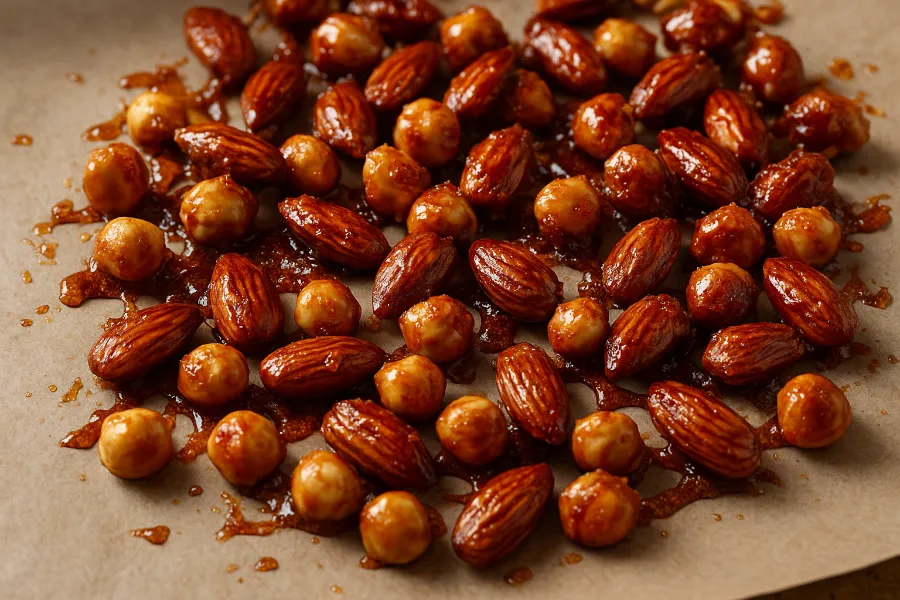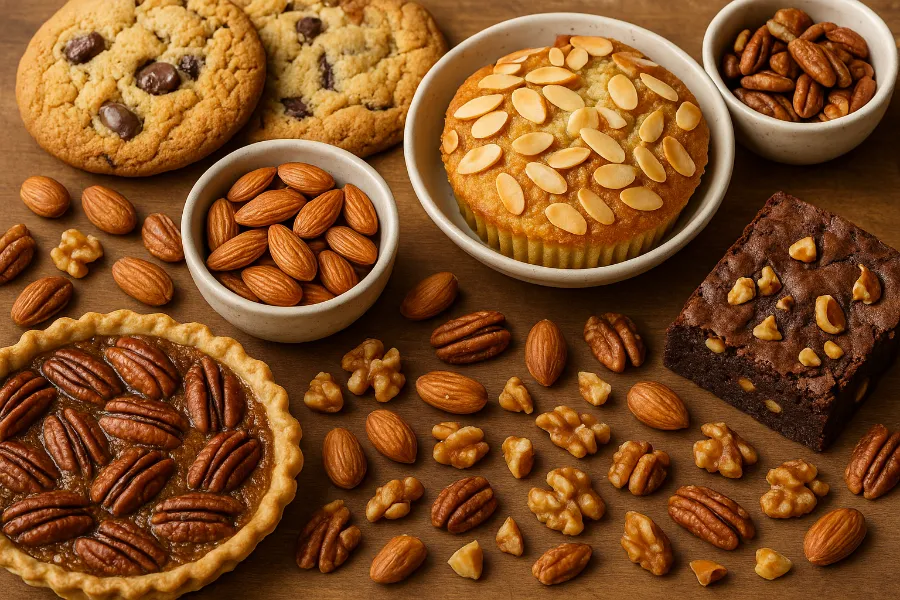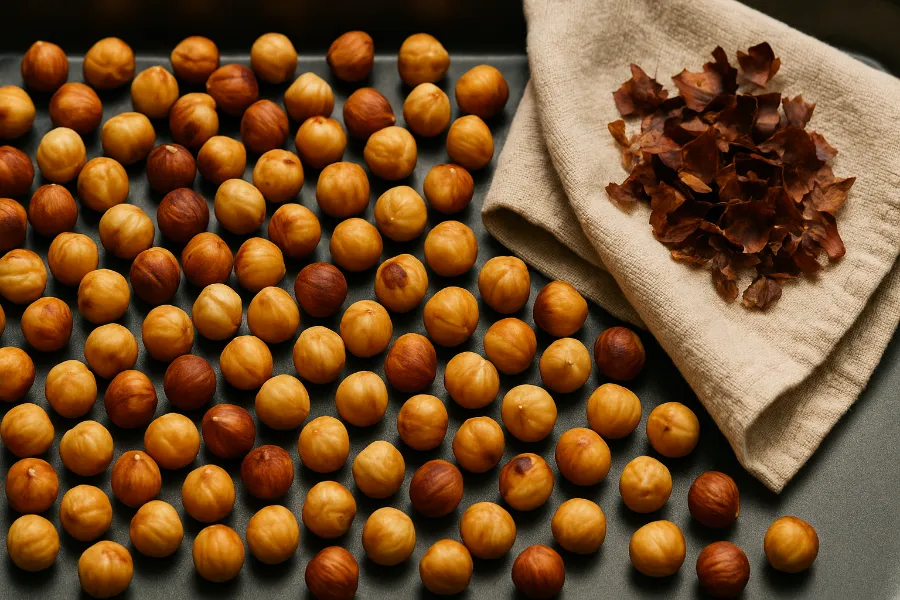If you’ve ever wondered why bakery desserts taste richer, warmer, and somehow more “finished,” the secret might be simpler than you think — it’s toasted nuts. Once I learned how to toast nuts for better dessert flavor, my cookies, cakes, and even ice-cream toppings changed forever. That light golden hue, the irresistible aroma, and the nutty crunch all come from just a few minutes of heat.
In this post, I’ll share how home bakers and pastry pros alike toast their nuts — the traditional ways you can do it with a sheet pan or skillet, and the chef-approved techniques that push flavor depth even further. You’ll also learn why nuts taste better when toasted, and how to master everything from oven toasted nuts to praline nuts at home.

Oven Toasted Nuts: The Easiest and Most Reliable Method
When you’re toasting nuts for a big batch of cookies or brownies, the oven is your best friend. Oven toasted nuts develop evenly browned surfaces and a deep aroma without constant stirring.
How to do it:
- Preheat your oven to 350°F (175°C).
- Spread the nuts in a single layer on a parchment-lined baking sheet.
- Bake for 5–10 minutes, shaking halfway through.
- Watch closely during the last minute — nuts can go from perfect to burnt in seconds.
- Transfer them to a cool plate immediately.
This works beautifully for almonds, pecans, walnuts, hazelnuts, and macadamias. The key is to toast just until fragrant. Once the scent fills your kitchen, they’re ready.
Pro tip: For tiny nuts like pine nuts, lower the oven to 325°F (160°C). Their oils heat quickly, and they burn fast.
Toasted Nuts: Why They’re Dessert Gold
The magic of toasted nuts lies in chemistry — when heat meets the natural oils and sugars inside nuts, it triggers the Maillard reaction. That’s the same delicious browning you see on toasted bread or grilled steak. The result? Complex flavors that taste like caramel, butter, and warm spice rolled into one.
Toasted nuts add contrast and depth to desserts. They cut through sweetness, add a crisp bite, and layer flavors that raw nuts simply can’t provide. Think of them as the seasoning of the dessert world — subtle, but game-changing.
Once you start using toasted nuts in your recipes, even your simplest desserts (like banana bread or chocolate bark) will taste gourmet.
Roasted Nuts: When You Want a Deeper, Bolder Flavor
Now, let’s talk about roasted nuts, the heartier cousins of toasted ones. The difference comes down to temperature and time. Toasting happens at a moderate heat (325–350°F), while roasting nudges a bit higher (375–400°F), creating darker color and deeper caramel notes.
If you’re making nut butters, savory desserts, or anything that needs an extra-rich nutty flavor — like dark-chocolate brownies — roasted nuts are your go-to.
Quick guide:
- 350°F (175°C) → gentle toast (light color, buttery taste).
- 375–400°F (190–205°C) → deeper roast (dark, bold, almost smoky).
Just remember: more color means stronger flavor — but also higher risk of bitterness if overdone. Always cool roasted nuts immediately to stop residual cooking.

Toasting Almonds: The All-Purpose Nut Upgrade
There’s a reason toasting almonds is practically a baking rite of passage. Almonds are mild when raw, but once toasted, they bloom with warm, sweet, nutty richness that complements everything from tarts to granola.
How to Toast Almonds (Two Ways):
Oven Method:
- Spread sliced, slivered, or whole almonds on a sheet pan.
- Bake at 350°F for 5–7 minutes, shaking halfway.
Stovetop Method:
- Heat a dry skillet over medium heat.
- Add almonds and toss often for 3–5 minutes until golden.
Flavor Tip:
For a dessert finish, toss warm almonds with a pinch of sea salt or a drizzle of honey — instant gourmet topping for ice cream or yogurt.
When I’m baking almond biscotti, I always toast the almonds first. The aroma alone tells me the cookies will taste ten times better.
Toasting Pecans: Caramel’s Best Friend
Toasting pecans brings out a buttery, caramel-like depth that makes any dessert feel nostalgic. Raw pecans can taste flat or oily, but when toasted, they develop a flavor reminiscent of toffee or browned butter.
How to Toast Pecans in the Oven:
- Preheat oven to 350°F.
- Arrange pecans in a single layer on parchment.
- Bake 7–9 minutes, stirring once.
- Cool completely before adding to batter or toppings.
Pro tip: For a Southern-style twist, toss warm toasted pecans in a touch of maple syrup and cinnamon. They make an incredible topping for sweet-potato pie or butter pecan ice cream.
Toasting Hazelnuts: Chocolate’s Perfect Partner

Toasting hazelnuts transforms them from bitter to buttery, especially once their papery skins are removed. This is essential for recipes like praline paste, gianduja (chocolate-hazelnut spread), or any nutty cake.
How to Toast and Peel Hazelnuts:
- Spread raw hazelnuts on a baking sheet.
- Roast at 350°F for 10–12 minutes until the skins crack.
- Wrap warm nuts in a kitchen towel and rub gently to remove most skins.
Toasted hazelnuts taste like roasted coffee and dark chocolate — no wonder pastry chefs love them.
Add chopped toasted hazelnuts to brownies or swirl them into melted chocolate for homemade Ferrero-style truffles.
Candied Nuts: Sweet, Crunchy, and Irresistible
Sometimes, you want more than just toast — you want crunch and shine. Enter candied nuts. This technique coats nuts in sugar, caramelizing them into glossy, sweet clusters perfect for topping cheesecakes, puddings, or festive cookies.
Basic Candied Nut Recipe:
- Combine 1 cup nuts, ½ cup sugar, and 2 tbsp water in a skillet.
- Cook over medium heat, stirring constantly until the sugar melts, crystallizes, and caramelizes.
- Pour onto parchment and separate while warm.
The result is dessert magic: crunchy, buttery, and sweet. You can even sprinkle a little sea salt for a salted-caramel vibe.
Pro twist: Add vanilla extract or cinnamon during the last 30 seconds of cooking. It enhances aroma and gives your candied nuts a “bakery-made” fragrance.
Roasted Almonds: Simple, Elegant, and Full of Flavor
Roasted almonds deserve their own spotlight. They’re the go-to for both sweet and savory desserts because of their balance — not too strong, not too mild.
If you’ve ever had almond croissants or almond-crusted biscotti, you’ve tasted the magic of roasted almonds.
Oven Instructions:
- Preheat to 375°F (190°C).
- Roast for 8–10 minutes, shaking once halfway.
- Let cool fully before storing.
For extra indulgence, toss roasted almonds in melted dark chocolate, sprinkle flaky salt, and chill until set. Instant luxury snack — and a perfect garnish for cakes or mousse.
Maillard Reaction: The Science Behind Toasted Flavor
Behind every perfectly toasted nut is the Maillard reaction — the cornerstone of flavor chemistry. When heat meets amino acids and sugars, hundreds of new flavor molecules form. It’s what gives bread crusts their golden color and makes roasted nuts smell heavenly.
In nuts, this reaction:
- Deepens color from pale beige to golden brown.
- Enhances aroma with caramel, coffee, and butter notes.
- Reduces bitterness (especially in walnuts and hazelnuts).
- Creates crunch by evaporating surface moisture.
Once you understand this, you’ll see why toasted nuts taste more “complete.” You’re not just warming them — you’re transforming them on a molecular level.
Baking Essentials: Why Every Baker Should Toast Nuts

If I had to list my top baking essentials, toasted nuts would rank right beside vanilla extract and butter. They’re tiny flavor bombs that elevate everything they touch.
Here’s how I use them in everyday desserts:
- Cookies: Fold toasted pecans or walnuts into chocolate-chip dough for texture.
- Cakes: Add chopped toasted almonds to buttercream for a subtle crunch.
- Pies: Sprinkle toasted pecans over pecan or pumpkin pie filling before baking.
- Brownies: Stir in toasted hazelnuts for a Ferrero Rocher-style bite.
- Mousses and ice creams: Blend in finely ground toasted nuts for richness.
If you’re just starting out, toast small batches until you know your oven’s “sweet spot.” It’s one of those baking essentials you’ll never skip again.
Praline Nuts: The Dessert Upgrade You Didn’t Know You Needed
When pastry chefs say “praline,” they mean two things: the caramelized nut crunch and the silky paste made from it. Either way, praline nuts are the ultimate flavor enhancer for fancy desserts.
How to Make Classic Praline Nuts:
- Toast 1 cup hazelnuts or almonds at 350°F for 8–10 minutes.
- In a saucepan, heat 1 cup sugar until golden brown.
- Stir in the toasted nuts quickly, then spread onto parchment.
- Once hardened, crush into shards or blitz into praline paste.
The result is pure gold — crunchy, sweet, and aromatic. Sprinkle crushed praline on top of eclairs, mix into ice cream, or blend into mousse for restaurant-quality texture.
Pro Chef Techniques for Perfect Toasting
Professional pastry chefs treat nut-toasting as flavor engineering. Here’s what they do differently:
1. Low-and-Slow Precision
Instead of quick, high heat, pros often toast nuts at 275°F (135°C) for up to 30 minutes. It develops flavor evenly without burning delicate oils — ideal for hazelnuts, pecans, and almonds.
2. Butter-Basting
Chefs sometimes toast nuts in browned butter, infusing them with nutty richness and golden color. This trick transforms even plain walnuts into dessert toppings you’ll want to eat by the handful.
3. Aromatic Add-Ons
Adding vanilla beans, orange zest, or espresso powder while toasting can infuse nuts with subtle complementary notes.
Imagine orange-scented pecans over chocolate cake — absolute heaven.
4. Sugar Toasting
A blend of sugar and nuts in the pan creates a light praline glaze that’s perfect for tarts or semifreddo toppings. It’s halfway between toasting and candy-making — all sparkle, all flavor.
5. Cooling Discipline
The final secret: remove nuts from heat immediately. Professionals spread them out on a cool tray so residual heat doesn’t take them from “perfectly golden” to “almost burnt.”
Why Toasted Nuts Make Desserts Taste Better
Here’s what happens when you toast nuts — and why it matters:
- Oils Warm Up: Fatty acids release aroma compounds that raw nuts keep locked in.
- Bitterness Drops: Especially in walnuts and hazelnuts, toasting tames harsh tannins.
- Texture Improves: A crisp shell forms, giving you that satisfying crunch.
- Sweetness Balances: The toasty, caramel-like notes mellow sugary desserts.
- Aromas Amplify: Toasted nuts don’t just taste better — they smell irresistible.
It’s the small detail that separates “good” desserts from unforgettable ones.
Tips for Consistent Toasting Every Time
- Don’t multitask. Nuts burn fast. Stay close.
- Stir halfway. This ensures even browning.
- Cool completely. Otherwise, they’ll steam and soften.
- Store smart. Keep toasted nuts in an airtight jar for up to a month or freeze for longer.
- Toast small batches. Freshness fades — smaller, more frequent toasting keeps flavor alive.
Final Thoughts: Toast Once, Taste Forever
Mastering how to toast nuts for better dessert flavor isn’t complicated — but it’s transformative. Whether you’re making oven toasted nuts for brownies, candied nuts for cheesecakes, or praline nuts for special-occasion pastries, this tiny step makes desserts taste richer, rounder, and far more professional.
The next time you bake, pause before tossing in raw nuts. Give them five golden minutes of heat. Your kitchen will smell divine, and your desserts will thank you — bite after crunchy, caramelized bite.
FAQs
Toasting nuts releases their natural oils and deepens their flavor through the Maillard reaction. It gives desserts a richer aroma, better crunch, and balanced sweetness.
Set your oven to 350°F (175°C) for most nuts. Smaller nuts like pine nuts or sliced almonds may need a lower temperature, around 325°F (160°C), to prevent burning.
They’re ready when they turn golden brown and smell fragrant. Always remove them immediately from the hot pan to stop further cooking.
Yes! Use a dry skillet over medium heat and stir frequently for 3–5 minutes. This is ideal for small batches or quick dessert toppings.
The heat triggers caramelization and the Maillard reaction, unlocking deeper, buttery, and slightly sweet flavors that raw nuts don’t have.
Once fully cooled, store them in an airtight container for up to a month. For longer freshness, freeze them for up to six months.
Absolutely! Tossing nuts in butter or sugar before toasting makes them glossy, flavorful, and perfect for praline, candied nuts, or dessert toppings.













